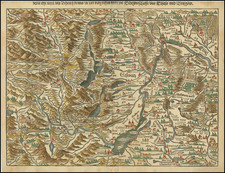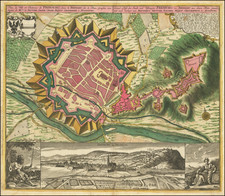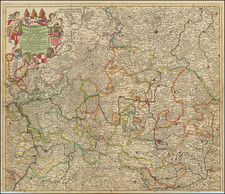Rare early 20th-century map centered on southern Germany, from Nancy, France east to Gmunden, Austria, and from Koblenz south to Innsbruck, Austria, prepared for use by the blind under the direction of the Marburger Blindenstudienanstall (Marburg Institute for the Blind).
Embossed on thick paper, the map features raised topographical features, using various symbols including:
- striated embossed lines for the ocean
- raised, dotted lines representing political borders
- raised lines for rivers
- raised 1/8th inch dot for cities and towns, surrounded by smaller dots if a major city like Munich or Strasbourg.
In the margins are coordinates, in braille, from 1 to 15 on the top and bottom and from A to G on the left and right.
The Marburger Blindenstudienanstall has continued to operate and is now German's national institute for the blind. It was created in the wake of World War I when many of Germany's youth returned from the War with impaired vision or total blindness. The director of the Marburg University Eye Clinic, Alfred Bielschowsky, began the project by setting up courses in 1915 to help these returning soldiers learn to live with impaired sight. He commissioned the then student Carl Strehl to lead the courses. Together they founded the Association of Blind Academics of Germany and raised funding from wealthy individuals, etc. The initial goal was to help the sight-impaired re-integrate into work and social life. By 1921, a grammar school was established. With the advent of Braille printing, programs flourished and the Institute became a thriving success for educating German's sight-impaired youth.









![[Bavaria and Baden-Württemberg] A Benigni Lettori, ecoui la descrittione del Ducato di Baviera, con gl altri Dominiijcirconvicini di nuovo con ogni deligentia revisto et dato in luce l'anno MDLXX . . .](https://storage.googleapis.com/raremaps/img/small/92018.jpg)




![[Weimar, Erfurt, Jena, Fuld, Gotha ] Weimaria / Iena . . . / Erdfordia . . . / Gotha . . . / Fuldensis . . .](https://storage.googleapis.com/raremaps/img/small/58637mp2.jpg)